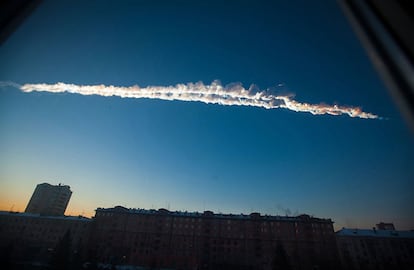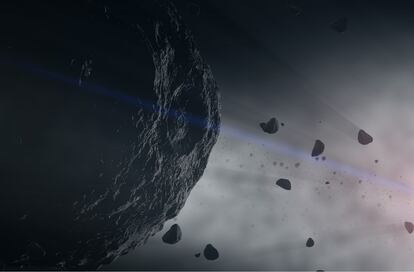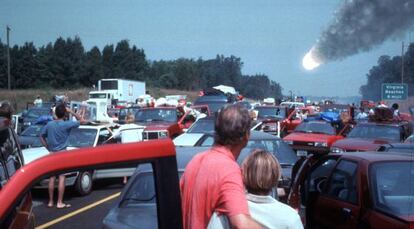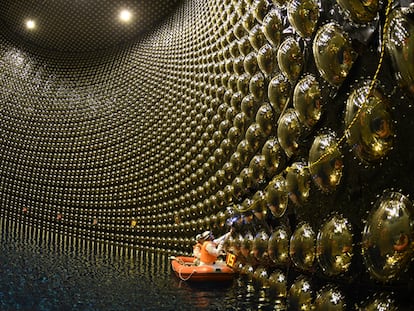Forget ‘Don’t Look Up’ – It won’t be lone scientists who are warning us about an apocalyptic event
The planetary defense against asteroids and comets like the one in the Netflix movie is coordinated by international astronomical organizations and alerting the population does not depend on any one person

In 1988, an astronomer felt the need to warn the world that the apocalypse was at hand, or at least could be. On behalf of the International Astronomical Union, scientist Brian Marsden broadcast that asteroid 1997-XF11, which measured 1,500 meters in diameter, would pass within 40,000 kilometers of Earth on October 26, 2028. It would graze us and a catastrophic impact could not be ruled out. This is the closest we have come to experiencing the scenario in the movie Don’t Look Up, recently released on Netflix: a PhD student played by Jennifer Lawrence discovers that a comet is on a catastrophic collision course with Earth, and together with her professor, played by Leonardo DiCaprio, she tries to warn an indifferent world.
The filmmakers took advice from one of NASA’s lead asteroid hunters, Amy Mainzer, and the movie is faithful to what such an event would be like – aside from the fact that such a problem would not be in the hands of two desperate scientists acting in a vacuum.
First off, the film is a comedy, although many have taken it seriously. It uses black humour and allegory to address our response to the climate crisis and, to an extent, Covid-19. According to the film’s director, Adam McKay, and its protagonist, Leonardo DiCaprio, “it’s about our inability to listen to scientific truths.” What happens if a comet the size of Everest comes towards Earth (climate crisis) and nobody cares? If an astronomer discovered that a gigantic space rock was going to wipe out life on the planet, what would actually happen?

“The way in which the discovery is depicted, aside from these observations and a few months of margin, is, I think, impeccable,” says astronomer Josep Maria Trigo, from the Institute of Space Sciences (CSIC-IEEC). “It would happen this way given these circumstances.” One night, home alone with her computer, Lawrence’s character picks up on an object hurtling through space which turns out to be a nine-kilometer comet. She passes the information to her astronomy professor (DiCaprio) in class and he proceeds to make calculations that lead to the inevitable conclusion that it will hit Earth with almost 100% certainty in six months. Humanity is doomed.
According to Julia de León, a specialist at the Canaries Institute of Astrophysics (IAC), those initial scenes are the least convincing. “First we make the discovery and an initial estimate of the orbit, which allows us to predict future impact probabilities, but with enormous margins of error,” she says. As the object is observed, an attempt is made to determine its position at various points in its orbit. “What tends to happen in the vast majority of cases is that, as you narrow it down, the margin of error becomes very small and the probabilities of impact are reduced to ridiculous amounts,” she adds.
But this is not always the case. When the asteroid Apophis was discovered in 2004, in what would have been a tense Christmas for astronomers, they began to seek ways to better calculate its route, which appeared to be direct to Earth. The more data came in, the more the risk of collision increased, as engineer María Eugenia Sansaturio explained at the time: it stood at 3% for 2036. Two years later, however, the danger was reduced to a minimum, and in 2013 it was finally ruled out.

Back then, the current international collaboration networks did not exist, nor the protocols that are currently being tested. Last April in Vienna, during the 7th Planetary Defense Conference, a simulation of the discovery of a dangerous asteroid took place: 2021 PDC would fall in a Central European region in six months. The trajectory and probability of collision was calculated and communicated by the International Asteroid Warning Network (IAWN), which is composed of organizations such as NASA, the European Space Agency (ESA) and the Chinese Academy of Sciences. At the same time, the Space Mission Planning Advisory Group (SMPAG) would begin to study the possibilities of intercepting or deflecting the asteroid.
The conference featured a paper titled “They don’t believe Covid, will they believe the asteroid impact?” by Austrian astronomers that lends credibility to the Netflix movie along with another titled “What can the Covid-19 pandemic teach the planetary defense community?” Scientists are aware that, as McKay suggests, there is more resistance to science in society than is desirable. The polarization of the pandemic and its deniers forced McKay to make his argument “20% crazier, because reality had played out crazier than the script.”
Both the Network IAWN and the SMPAG were created in 2014 on the insistence of the United Nations Office for Outer Space Affairs, led by astrophysicist and astronautics expert Simonetta di Pippo. Now, data collection is coordinated, calculations are verified before being disseminated, and all countries on the planet are made aware of the existential risk. “When there is a risk, we always work in collaboration,” explains De León. “There is an international monitoring network rather than one astronomer or one country. We have to cooperate, observe from the northern and southern hemisphere, have all flanks covered.”

Consequently, countless scientists and organizations will know of any news and it would not be down to those who first discovered anything treacherous to spread the word. For several years now, both NASA and ESA have respective heads of Planetary Defense: Lindley Johnson and Detlef Koschny. If Simonetta di Pippo appears with these men on television, it will be a fairly reliable sign that something of note is going on.
“To be surprised by an object of that size would be very rare,” says De León. “They are practically all located: we know where they go and none has a probability other than zero in the next 100 years.” Those are the ones that would put humanity in a bind, more than 95% of which were located due to a US Senate mandate. However, those which are not apocalyptic, but merely terrifying, are not so controlled. “Things start to get interesting with those that are between 100 meters and one kilometer [like Apophis], because that size range is the least well-mapped; we only know of 30%,” she admits.
This summer, NASA announced at a press conference that it had calculated in as much detail as possible the trajectory of asteroid Bennu, a 500-meter rock. It announced that there was an “extremely small” chance – 0.057% – that it would reach Earth on September 24, 2182. In this case, the probabilities were minor and distant in time, but it was announced anyway because NASA had “visited” Bennu, had taken samples and had the data.

But if the risk were above 1% in the next 50 years, things would change. Alerts would be activated and, of course, those who discovered the risk would not be personally responsible for raising the alarm, as Trigo points out: “The communication aspect is lame in the film,” he says. “Obviously the data is verified by more experts and they [Lawrence and DiCaprio] have a protagonism that they wouldn’t have in reality.” Countries that discover any high-risk object are legally obliged to report it, according to the UN Office. ESA, for example, is required to review it with an independent entity such as NASA, publicize an impact warning, and share it with IAWN.
In the movie, the chance of impact is close to 100%. But, according to De León, “if there were a high risk, the international community would be on the move to observe it and within a continuous week of observations we would be fine-tuning that risk to a great extent. It’s possible that as you observe an approaching object, you might see that it will impact. Fortunately, this has not yet happened to us.”
In 1998, it was Morgan Freeman in the role of the calm and transcendental President Beck who warned of the lethal impact of a comet in the movie Deep Impact. That same year, in the real world, Brian Marsden, the astronomer who issued the warning about asteroid 1997-XF11, was given a hard time, as The New York Times flagged up recently: his warning was based on a single calculation that did not take into account all the variables. The next day, NASA put out a clarifying statement: “The chances of it hitting our planet are currently zero,” said astronomer Don Yeoman, who recalculated the asteroid’s orbit. “Why was the press release out there before the data was presented and consulted with colleagues? I don’t know.” Two decades later, such an announcement would be much better thought out and consensual. In fiction, however, they have traded Freeman’s sobriety for Lawrence and DiCaprio’s desperation, which could well be a sign of the times.
Why a comet?
Director Adam McKay and his advisor, asteroid specialist Amy Mainzer, have revealed in The New Yorker that Mainzer suggested reducing the size of the comet in the movie from the original 32 to nine kilometers, so that it would actually be possible to do something about it. “I said, ‘No, no – if it’s too big, people just throw up their hands,’ " Mainzer told the magazine.
But when Mainzer proposed that they should have years to act, rather than just six months, McKay was not convinced. The director wanted a response to be urgent and unpostponable. “I can tell you that we wouldn’t have the capacity to react to avoid such a collision: with only six months, we’re toast,” says De León. “It would be impossible,” agrees Trigo. Both De León and Trigo participate in NASA’s DART mission, which for the first time in history will try to deflect an asteroid by hitting it with a space probe. In 2024, ESA’s Hera probe will test whether it was a success. It is important to note, of course, that this is only a test – the asteroid they intend to deflect is not coming this way.
Although the large objects are almost all controlled, it is not impossible that we could get a scare with as little as six months warning, or less. The 17-meter, 10,000-ton asteroid that tore through the atmosphere over Chelyabinsk was spotted when it was already upon us and was a once-in-100-year event. “There are all kinds of objects that have been dropped on us as soon as we’ve discovered them – obscure objects, with eccentric orbits, that give us very few weeks of margin,” Trigo points out. Regarding asteroid 2015-TB145, a 600-meter, 300-million-ton fragment detached from a comet, we had only three weeks of margin before impact.
Perhaps that is why in both Don’t Look Up and the 2020 cataclysmic movier Greenland, directed by Ric Roman Waugh and released on Amazon Prime, the space object that hits us is a comet. “A large object that is a global destroyer as the movies paint it, is more likely to be a comet because we have already located the large asteroids,” says De León. “From time to time we discover new comets, with eccentric orbits, coming from very distant regions.”
Meanwhile, Trigo explains that comets have unpredictable movements because the gas and dust currents cause them to have very unstable trajectories. “It is a much more improbable phenomenon than an asteroid, with a frequency of one billion years; highly improbable. But if it impacts, it does so with greater energy, because of those eccentric orbits, and has an enormous destructive capacity. As in the movie, it would cause devastation on a global scale,” he says.
Tu suscripción se está usando en otro dispositivo
¿Quieres añadir otro usuario a tu suscripción?
Si continúas leyendo en este dispositivo, no se podrá leer en el otro.
FlechaTu suscripción se está usando en otro dispositivo y solo puedes acceder a EL PAÍS desde un dispositivo a la vez.
Si quieres compartir tu cuenta, cambia tu suscripción a la modalidad Premium, así podrás añadir otro usuario. Cada uno accederá con su propia cuenta de email, lo que os permitirá personalizar vuestra experiencia en EL PAÍS.
¿Tienes una suscripción de empresa? Accede aquí para contratar más cuentas.
En el caso de no saber quién está usando tu cuenta, te recomendamos cambiar tu contraseña aquí.
Si decides continuar compartiendo tu cuenta, este mensaje se mostrará en tu dispositivo y en el de la otra persona que está usando tu cuenta de forma indefinida, afectando a tu experiencia de lectura. Puedes consultar aquí los términos y condiciones de la suscripción digital.
More information
Archived In
Últimas noticias
More than 40 Democratic lawmakers urge Trump in a letter to stop his ‘attempts to undermine democracy in Brazil’
The journal ‘Science’ criticizes Trump’s anti-renewable energy policy: ‘The US is failing to benefit from its own innovations’
Cubans hope for a miracle as dengue and chikungunya spread
The long shadow of the father figure in the films of Rob Reiner
Most viewed
- Christian Louboutin: ‘Young people don’t want to be like their parents. And if their parents wear sneakers, they’re going to look for something else’
- Cartels in Mexico take a leap forward with narco-drones: ‘It is criminal groups that are leading the innovation race’
- ‘El Limones’ and the growing union disguise of Mexican organized crime
- Liset Menéndez de la Prida, neuroscientist: ‘It’s not normal to constantly seek pleasure; it’s important to be bored, to be calm’
- The low-cost creative revolution: How technology is making art accessible to everyone











































